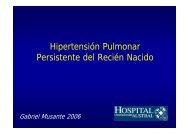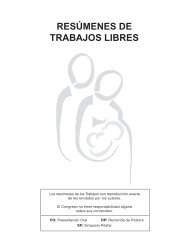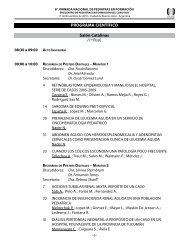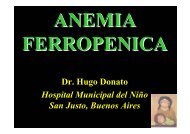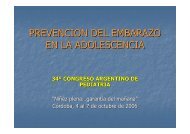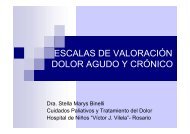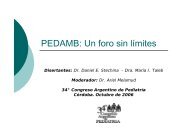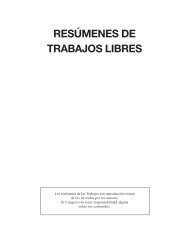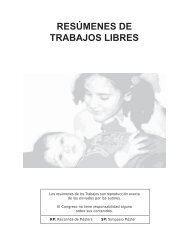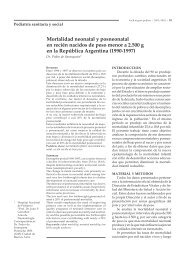Hidrops vesicular agudo: forma de presentación no habitual de ...
Hidrops vesicular agudo: forma de presentación no habitual de ...
Hidrops vesicular agudo: forma de presentación no habitual de ...
Create successful ePaper yourself
Turn your PDF publications into a flip-book with our unique Google optimized e-Paper software.
134 COMENTARIO BREVE ARCH ARG PEDIATR<br />
Comunicación breve<br />
<strong>Hidrops</strong> <strong>vesicular</strong> <strong>agudo</strong>: <strong>forma</strong> <strong>de</strong><br />
presentación <strong>no</strong> <strong>habitual</strong> <strong>de</strong> hepatitis viral aguda tipo A<br />
Dres. DANIEL CREUS*, ELENA INSUA** y CARLOS GUTIERREZ**<br />
RESUMEN<br />
El hidrops <strong>vesicular</strong> <strong>agudo</strong> es una patología poco frecuente<br />
en la práctica pediátrica.<br />
Debe diferenciarse <strong>de</strong> la colecistitis aguda alitiásica, <strong>de</strong> la<br />
colelitiasis y <strong>de</strong>l síndrome <strong>de</strong> bilis espesa.<br />
Presentamos un niño con hepatitis viral aguda <strong>de</strong> tipo A,<br />
cuya <strong>forma</strong> <strong>de</strong> presentación fue dolor abdominal causado por<br />
hidrops <strong>vesicular</strong> <strong>agudo</strong>.<br />
Palabras clave: hidrops <strong>vesicular</strong>, hepatitis viral aguda.<br />
SUMMARY<br />
Acute hidrops of the gallblad<strong>de</strong>r is an unusual pathologic<br />
condition, that is encountered primarily in children.<br />
It must be differentiated from the acute acalculus cholecistitis,<br />
cholelythiasis and the bile-plug syndrome.<br />
We report a child with acute viral hepatitis, type A, which<br />
presentation form was with abdominal pain, secondary to acute<br />
hydrops of the gallblad<strong>de</strong>r.<br />
Key words: gallblad<strong>de</strong>r hydrops, acute viral hepatitis.<br />
ARCH ARG PEDIATR / 1998 / VOL. 96: 134<br />
INTRODUCCION<br />
<strong>Hidrops</strong> <strong>vesicular</strong> <strong>agudo</strong>, colecistitis aguda<br />
alitiásica y colecistitis litiásica son situaciones patológicas<br />
diferentes poco comunes en niños y, a<br />
menudo, confundidas entre sí.<br />
El hidrops <strong>vesicular</strong> <strong>agudo</strong> 1 se caracteriza por<br />
una distensión <strong>vesicular</strong> masiva, en un niño agudamente<br />
enfermo, en ausencia <strong>de</strong> mal<strong>forma</strong>ciones<br />
congénitas, litiasis o infecciones bacterianas locales.<br />
2-4<br />
La colecistitis alitiásica aguda es una <strong>de</strong><strong>no</strong>minación<br />
frecuentemente usada como sinónimo <strong>de</strong><br />
hidrops <strong>vesicular</strong> <strong>agudo</strong>, <strong>de</strong>biendo ser reservada<br />
para casos <strong>de</strong> vesículas infectadas, sin cálculos,<br />
en un paciente con un cuadro <strong>de</strong> infección severa. 5<br />
La colecistitis litiásica aguda es me<strong>no</strong>s común<br />
en niños que en adultos, aunque con el advenimiento<br />
<strong>de</strong> la ultraso<strong>no</strong>grafía se <strong>de</strong>mostró que es<br />
más frecuente <strong>de</strong> lo que se pensaba, sobre todo en<br />
la adolescencia.<br />
Por último, po<strong>de</strong>mos mencionar, <strong>de</strong>ntro <strong>de</strong> los<br />
diagnósticos diferenciales, al síndrome <strong>de</strong> bilis<br />
espesa. 6 En éste se encuentra una obstrucción<br />
* Médico pediatra, médico ecografista.<br />
** Médico pediatra.<br />
Hospital Sub-zonal San Pedro.<br />
Correspon<strong>de</strong>ncia: Dr. Daniel Creus. Máximo Millán 1198. San<br />
Pedro, Pcia. Bs. As.<br />
extrahepática <strong>de</strong> la vía biliar por un espesamiento<br />
<strong>de</strong> la secreción biliar, generalmente en neonatos<br />
que presentan sepsis, <strong>de</strong>shidratación aguda,<br />
hemólisis masiva por incompatibilidad rh o ABO,<br />
fibrosis quística o nutrición parenteral total.<br />
Se presenta un niño <strong>de</strong> 6 años que ingresó a<br />
nuestro hospital con un cuadro <strong>de</strong> hidrops <strong>vesicular</strong><br />
<strong>agudo</strong>, se discutió acerca <strong>de</strong> las etiologías<br />
probables <strong>de</strong> dicha afección y se arribó a conclusiones<br />
acerca <strong>de</strong> la causa en nuestro paciente.<br />
HISTORIA CLINICA<br />
Niño <strong>de</strong> 6 años que ingresó por guardia, presentando<br />
dolor abdominal <strong>agudo</strong> y vómitos, se encontraba<br />
afebril y refirió malestar general en las últimas<br />
24 hs.<br />
En el examen físico se encontró a la palpación<br />
una tumoración dolorosa en el abdomen, que se<br />
extendía <strong>de</strong>s<strong>de</strong> el hipocondrio <strong>de</strong>recho hasta la<br />
altura <strong>de</strong>l ombligo. El resto <strong>de</strong>l abdomen se presentaba<br />
blando, <strong>de</strong>presible, sin reacción peritoneal,<br />
con ruidos hidroaéreos conservados.<br />
En la anamnesis <strong>no</strong> se recogieron datos relacionados<br />
con la enfermedad actual, y el resto <strong>de</strong>l<br />
examen físico <strong>no</strong> presentaba otros datos positivos.<br />
Se realizó por guardia una ecografía (con ecógrafo<br />
<strong>de</strong> tiempo real y escala <strong>de</strong> grises), en la que se<br />
observó leve hepatomegalia, vesícula alitiásica, <strong>de</strong><br />
pare<strong>de</strong>s finas y aumentada <strong>de</strong> tamaño con una
VOL. 96/1998 HIDROPS VESICULAR AGUDO: FORMA DE PRESENTACION NO HABITUAL DE HEPATITIS VIRAL AGUDA TIPO A<br />
135<br />
longitud <strong>de</strong> 9 cm y 3,5-4 cm <strong>de</strong> diámetros (Fotografía<br />
1). Bazo, riñones, páncreas <strong>de</strong> características<br />
ecográficas <strong>no</strong>rmales, <strong>no</strong> se visualizó líquido libre en<br />
cavidad peritoneal, <strong>de</strong>scartándose la presencia <strong>de</strong><br />
otras masas abdominales.<br />
Los estudios <strong>de</strong> laboratorio agregaron los siguientes<br />
resultados: hematocrito 32%; recuento <strong>de</strong><br />
glóbulos blancos: 8.700/mm 3 ; fórmula leucocitaria<br />
con predominio <strong>de</strong> linfocitos 52%; recuento <strong>de</strong><br />
plaquetas 195.000/mm 3 ; ERS: 32 mm 1ª hora;<br />
glucemia, uremia, io<strong>no</strong>grama <strong>no</strong>rmales; TGP: > 120<br />
UI/L; TGO: 60 UI/L; fosfatasa alcalina 1.100 UI/L;<br />
bilirrubina total 1,8 mg% y directa 0,9 mg%; investigación<br />
<strong>de</strong> Chagas por ELISA: negativo; hepatitis B y<br />
C por ELISA: negativo; HIV: negativo. Anticuerpos<br />
anti-virus <strong>de</strong> hepatitis A IgM positivo.<br />
El paciente se mantuvo en ayu<strong>no</strong> con hidratación<br />
parenteral las primeras 48 horas. Los controles<br />
<strong>de</strong> medio inter<strong>no</strong> permanecieron <strong>no</strong>rmales y,<br />
ecográficamente, se observó una paulatina disminución<br />
<strong>de</strong>l tamaño <strong>vesicular</strong> que, al cabo <strong>de</strong> 3 días,<br />
se encontraba en valores <strong>no</strong>rmales (Fotografía 2),<br />
con persistencia <strong>de</strong> leve hepatomegalia. La remisión<br />
<strong>de</strong> la sig<strong>no</strong>sintomatología fue total entre el<br />
tercer y cuarto día, tolerando bien la alimentación.<br />
En ningún momento presentó ictericia, coluria ni<br />
hipocolia.<br />
Se controló ambulatoriamente hasta la <strong>no</strong>rmalización<br />
<strong>de</strong>l hepatograma.<br />
DISCUSION<br />
El hidrops <strong>vesicular</strong> <strong>agudo</strong> es una patología poco<br />
común; se la encuentra en la literatura pediátrica<br />
como acompañante o siendo consecuencia <strong>de</strong> diferentes<br />
entida<strong>de</strong>s <strong>no</strong>sológicas <strong>de</strong> base. 5,7-11 La edad <strong>de</strong><br />
presentación varía <strong>de</strong>s<strong>de</strong> el nacimiento hasta los 15<br />
años, encontrándose con mayor frecuencia alre<strong>de</strong>dor<br />
<strong>de</strong> los 5 años. Es posible encontrar hidrops <strong>vesicular</strong><br />
durante el transcurso o en la convalecencia <strong>de</strong> infecciones<br />
respiratorias, otitis media y gastroenteritis. 4-12<br />
También se lo encuentra <strong>de</strong>scripto en el síndrome <strong>de</strong><br />
Kawasaki, las infecciones estreptocócicas, las<br />
leptospirosis y la linfoa<strong>de</strong>nitis mesentérica. 13 La causa<br />
<strong>de</strong> la distención <strong>vesicular</strong> masiva es incierta, aunque<br />
se sugiere que pue<strong>de</strong> ser secundaria a una obstrucción<br />
transitoria y autolimitada <strong>de</strong>l conducto cístico,<br />
habiéndose encontrado en algu<strong>no</strong>s casos hiperplasia<br />
<strong>de</strong> los ganglios linfáticos adyacentes a la unión <strong>de</strong>l<br />
cístico con el hepatocolédoco, causando una obstrucción<br />
mecánica, o bien reacción inflamatoria <strong>de</strong>l conducto<br />
cístico frente a esta linfa<strong>de</strong>nitis. 2-4 El síndrome<br />
<strong>de</strong> Kawasaki 10 es una enfermedad <strong>de</strong> baja prevalencia<br />
en niños, en la cual el hidrops <strong>vesicular</strong> es un hallazgo<br />
<strong>de</strong>scripto como típico <strong>de</strong> la afección.<br />
La hepatitis viral aguda es una enfermedad muy<br />
frecuente en la población pediátrica, en la cual es<br />
común observar una amplia variedad <strong>de</strong> hallazgos en<br />
cuanto a síntomas y sig<strong>no</strong>s clínicos. Todos los autores<br />
refieren la aparición <strong>de</strong> dolor abdominal, náuseas,<br />
vómitos, sig<strong>no</strong> <strong>de</strong> Murphy positivo, hepatomegalia,<br />
FOTOGRAFÍA 1 FOTOGRAFÍA 2
136 COMENTARIO BREVE ARCH ARG PEDIATR<br />
a<strong>de</strong><strong>no</strong>megalias y esple<strong>no</strong>megalia, pero sólo hay dos<br />
casos <strong>de</strong> hidrops <strong>vesicular</strong> <strong>agudo</strong> comunicados en la<br />
literatura. 14 Sería <strong>de</strong> interés estudiar si, en realidad, el<br />
hidrops <strong>vesicular</strong> <strong>agudo</strong> <strong>no</strong> es algo más que un hallazgo<br />
y si <strong>no</strong> se trata <strong>de</strong> una alteración frecuente pero <strong>no</strong><br />
<strong>de</strong>scripta, hasta el momento, <strong>de</strong>ntro <strong>de</strong> la historia<br />
natural <strong>de</strong> la enfermedad.<br />
El presente caso clínico se trató <strong>de</strong> un paciente<br />
con una hepatitis viral aguda tipo A cuya <strong>forma</strong> <strong>de</strong><br />
comienzo fue dolor abdominal causado por un<br />
hidrops <strong>vesicular</strong> <strong>agudo</strong>. Encontramos sólo una<br />
<strong>de</strong>scripción <strong>de</strong> esta <strong>forma</strong> <strong>de</strong> comienzo <strong>de</strong> hepatitis<br />
viral en la literatura, por lo que consi<strong>de</strong>ramos que<br />
esta comunicación cobra particular interés. ❚<br />
BIBLIOGRAFIA<br />
1. Kumari S, Lee WS, Baron MG. Hydrops of the gallblad<strong>de</strong>r in a<br />
child; diag<strong>no</strong>sis by ultrasound. Pediatrics 1979; 63: 295-297.<br />
2. Chamberlain JW, Hight DW. Acute hydrops of the gallblad<strong>de</strong>r.<br />
Am J Dis Child 1980; 134: 891-892.<br />
3. New J, Arvin A, Ariag<strong>no</strong> RL. Hydrops of the gallblad<strong>de</strong>r. Am J Dis<br />
Child 1980; 134: 891-892.<br />
4. Rumley TO, Rodpers BM. Hydrops of the gallblad<strong>de</strong>r in children.<br />
J Pediatr Surg 1983; 18: 138-140.<br />
5. Temberg LS, Keating SP. Acute acalculus cholecystitis<br />
complication of other illnesses in childhood. Arch Surg 1975,<br />
110: 543-547.<br />
6. Pheiffer WR, Robinson LH, Balsara VJ. So<strong>no</strong>graphic features of<br />
bile plug syndrome. J Ultrasoud Med 1986; 5: 161-164.<br />
7. Armspiger LA, Martín JG, Krempin HO. Acute <strong>no</strong>n calculus<br />
cholecyistitis in children. Am J Surg 1960; 100: 103-106.<br />
8. Callahan J, Haller JO, Cacciarelli AA, Slovis TL. Colelithiasis in<br />
infants, association with total parenteral nutrition and furosemid.<br />
Radiology 1982; 143: 437-490.<br />
9. Greenberg M, Kamgarloo H, Cochran ST, Sample WF. The<br />
ultraso<strong>no</strong>graphic diag<strong>no</strong>sis of cholecystitis and cholelithiasis in<br />
children. Radiology 1980; 137: 745-749.<br />
10. Grisoni E, Fisher R, Izant R. Kawasaki syndrome: Report of four<br />
cases with acute gallblad<strong>de</strong>r hydrops. J Pediatr Surg 1984; 19:<br />
9-11.<br />
11. Dinulos J, Mitchel D, Egerton J, Pickering L. Hydrops of the<br />
gallblad<strong>de</strong>r associated with Epstein-Barr virus infection: a report<br />
of two cases and review of the literature. Pediatr Infect Dis J<br />
1994; 13: 924-929.<br />
12. Tamayo Lopez G et al. Hydrops of the gallblad<strong>de</strong>r in childhood.<br />
An Esp Pediatr 1997; 47: 188-190.<br />
13. Barton LL et al. Hydrops of the gallblad<strong>de</strong>r in childhood infection.<br />
Pediatric Infect Dis J 1995; 14: 163-164.<br />
14. Mc Gahan JJ, Whittngill JA. Acute idiopatic hydrops of the<br />
gallblad<strong>de</strong>r <strong>no</strong>t due to calculi, possibly to infectious hepatitis.<br />
Report of two cases in neighboring children. Pediatrics 1958; 21:<br />
91-93.




